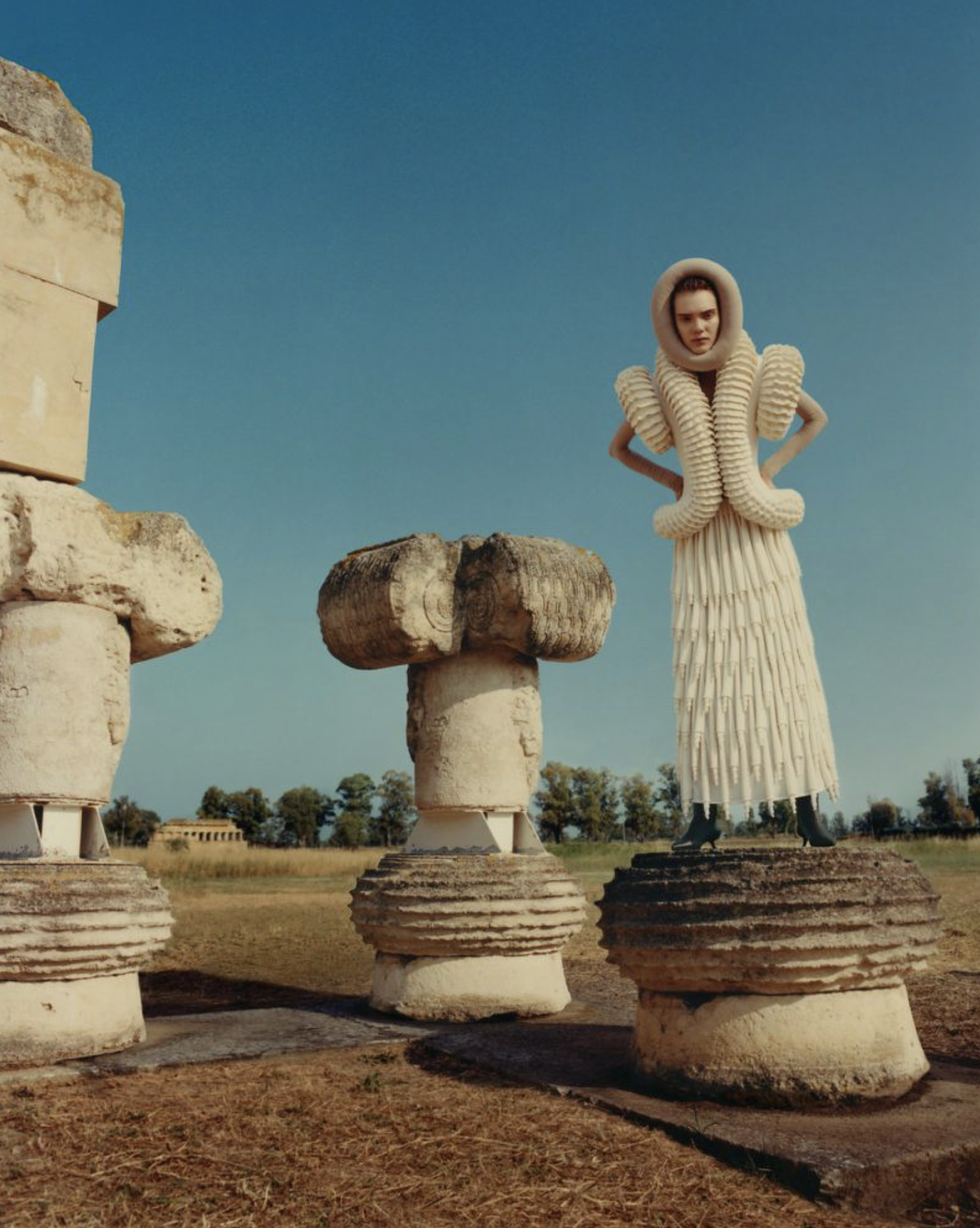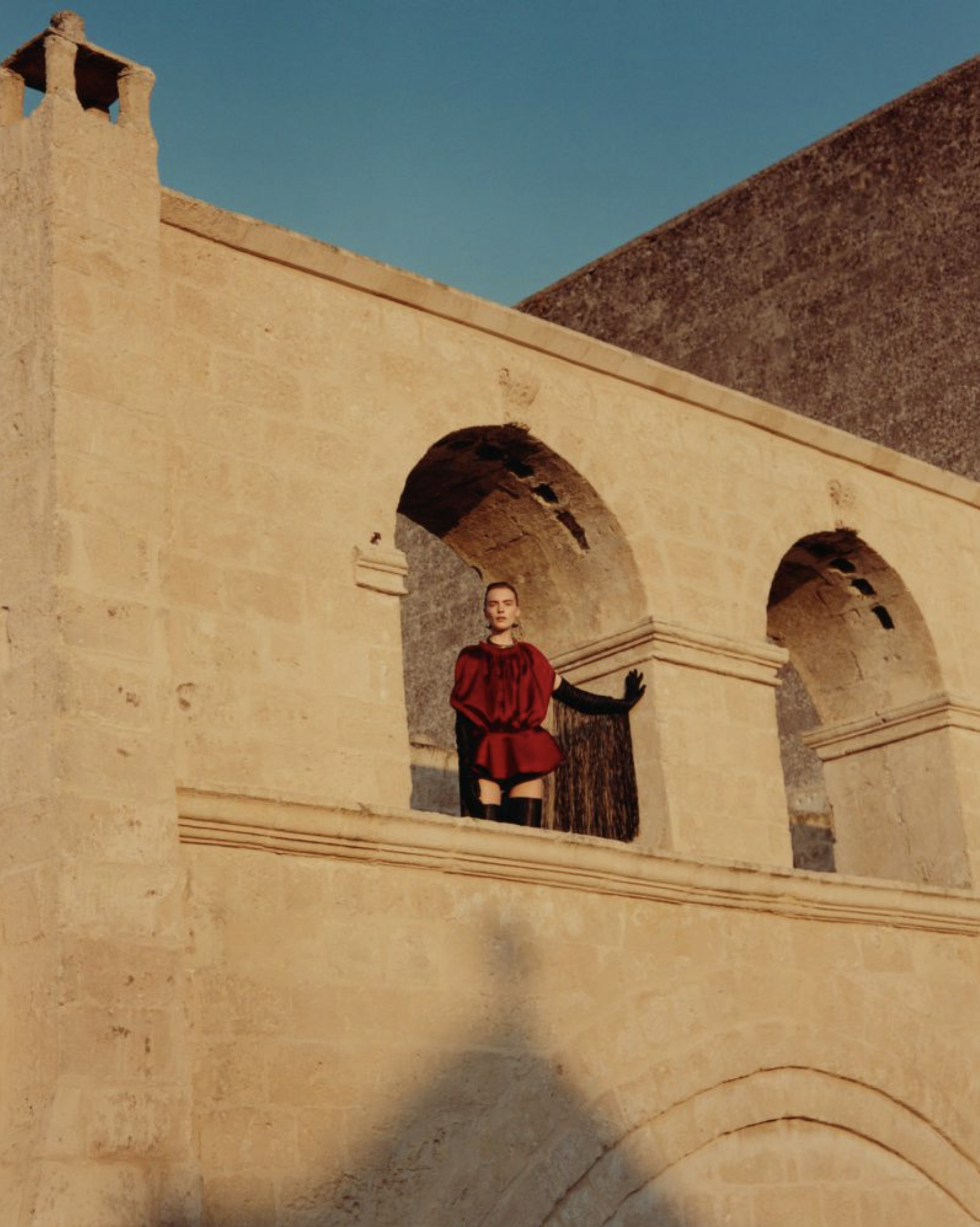Vogue Italia September 2025 Fashion Sculptures in Tempio di Hera Metaponto
/The Greeks in Southern Italy
Metaponto, located in the fertile region of Basilicata in southern Italy, traces its origins to ancient Greek colonization during the 7th century BCE. The Greeks were attracted to the area because of its rich soil, ideal for agriculture, especially grain cultivation, which would later make Metaponto a significant agrarian hub in Magna Graecia.
According to historical accounts, the town was founded by settlers from Achaea, a region in the northern Peloponnese, who sought to expand their influence and access new resources.These settlers were driven by the search for new arable lands and trading opportunities, as overpopulation and economic pressures in mainland Greece encouraged expansion overseas.
Metaponto As a Cultural Center
Metaponto quickly became part of the network of Greek polities in Magna Graecia, a term used to describe the cluster of wealthy and influential Greek colonies in southern Italy. The city became a cultural center, attracting philosophers and artists. Pythagoras himself is said to have spent time in Metaponto, further elevating its status. Over time, Metaponto developed into a significant and thriving city, integral to the overarching narrative of Greek colonization and cultural exchange in the Mediterranean region and across southern Italy.
The town's strategic position along the Ionian Sea facilitated maritime trade, allowing it to thrive economically and culturally. Metaponto's layout reflected typical Greek urban planning, with carefully organized streets and public spaces. Central to the city's religious and civic life was the impressive sanctuary dedicated to the goddess Hera, known as the Tempio di Hera. This temple, along with others in the region, underscored the settlers' commitment to preserving their Hellenic identity and religious practices.
Tempio di Hera in Metaponto
Hera, being the goddess of marriage and childbirth, was especially honored, reinforcing the cultural ties between the colonists and their homeland. Over time, Metaponto grew into a vibrant city-state, marked by a blend of Greek and local influences that would shape its legacy for centuries.
The architectural significance of the Tempio di Hera is indelibly linked to its symbolic role as a civic and religious center. It served as a focal point for community gatherings, religious ceremonies, and governance, integrating the spiritual and social dimensions of life in Metaponto. Today, although only remnants remain, the temple continues to be a vital link to understanding the historical significance and artistic achievements of the ancient Greeks in Italy.
In the bustling environment of Metaponto, the temple provided a center for community gatherings and rituals, which reinforced social cohesion among the inhabitants. The architectural grandeur of the temple, with its imposing columns and intricate designs, reflected the wealth and power of the city-state, serving as a testament to the Greek settlers' ambition and their mastery in art and architecture.
The Tempio di Hera was an essential part of the network of sanctuaries spread across Magna Graecia, fostering a shared religious and cultural identity among the Greek colonies in the region. Pilgrims and travelers from different parts of the Greek world visited the Tempio di Hera, facilitating cultural exchange and trade connections. This interaction helped integrate the colonies into the wider Hellenic world.
Roman Influence In Greece: Reverence to Military Conquest
The establishment and growth of Roman influence in Greece was a gradual process marked by a blend of military conquest, diplomacy, and cultural exchange. Initially, the Romans viewed Greece with a degree of reverence due to its rich cultural heritage. However, strategic interests soon dictated a more assertive approach. The pivotal moment came during the Macedonian Wars in the 3rd and 2nd centuries BCE, where Rome systematically dismantled the power of Macedonian kings, wielding their military might to assert dominance.
In 146 BCE, after the decisive Battle of Corinth, Greece was absorbed into the Roman Republic as the province of Achaea. This marked the beginning of direct Roman rule, which, although oppressive at times, also facilitated the blending of Greek and Roman cultures, often referred to as 'Greco-Roman'. While Roman governance brought structural changes, including the introduction of Roman law and infrastructure, it also encouraged the preservation of Greek traditions.
Military Domination and Cultural Integration
Admittedly, AOC has underappreciated the mutual respect involved in this historical synergy even though Greece and Italia were rivals and Rome eventually won.
Roman influence deepened through the encouragement of Greek studies, arts, and philosophy in Roman education. Politically, Rome utilized local elites to maintain control, promoting a sense of cooperation. Over time, many Greek cities flourished under Roman rule, benefiting from peace and improved trade networks. This period laid the groundwork for a lasting legacy where Greek culture profoundly impacted Roman society, illustrating a complex interplay of domination and cultural integration.
Meanwhile, Rome's strength lay in its highly disciplined military and pragmatic political systems.
As Rome's ambitions grew, it began to assert dominance over territories historically influenced by Greek culture. The Punic Wars marked a turning point, allowing Rome to expand into areas like Sicily, previously under Greek sway. This encroachment led to tensions as Rome increasingly came into contact with Greek colonies and city-states in Southern Italy and beyond. The conquest of Greece itself in the 2nd century BCE by Roman forces marked the culmination of these conflicts, leading to Rome adopting and adapting elements of Greek culture, even as it imposed political control.
The Birth of Christianity
The birth of Christianity marks a pivotal chapter in the history of Rome and its relations with Greece, as both powers competed for influence. Christianity emerged in the Roman Empire during the 1st century AD, arising from the Jewish traditions in the region of Judea, then under Roman rule. Jesus of Nazareth's teachings, which emphasized love, compassion, and a personal relationship with God, diverged from traditional Roman and Greek religious practices.
Despite early persecution by Roman authorities, Christianity's appeal grew, transcending cultural and social boundaries within the empire. When the Western Roman Empire fell, Christianity continued as a significant force in the Eastern Roman Empire, also known as the Byzantine Empire.
The Pax Romana, a period of relative peace and stability across Roman territories, allowed for the exchange of ideas, aiding in the dissemination of Christian beliefs. Rome's vast network of roads and the use of Greek as a lingua franca facilitated this spread. Missionaries like Paul of Tarsus played a crucial role in reaching diverse communities, establishing the foundations of the early Church.
As Christianity spread, it began to gain a stronghold in major cities, including Rome itself.
Emperor Constantine’s Conversion to Christianity
By the 4th century, Roman Emperor Constantine's conversion to Christianity and the Edict of Milan legitimized the religion, marking a significant shift in its status. Constantinople (formerly Byzantium) became the new capital of the Roman Empire.
































